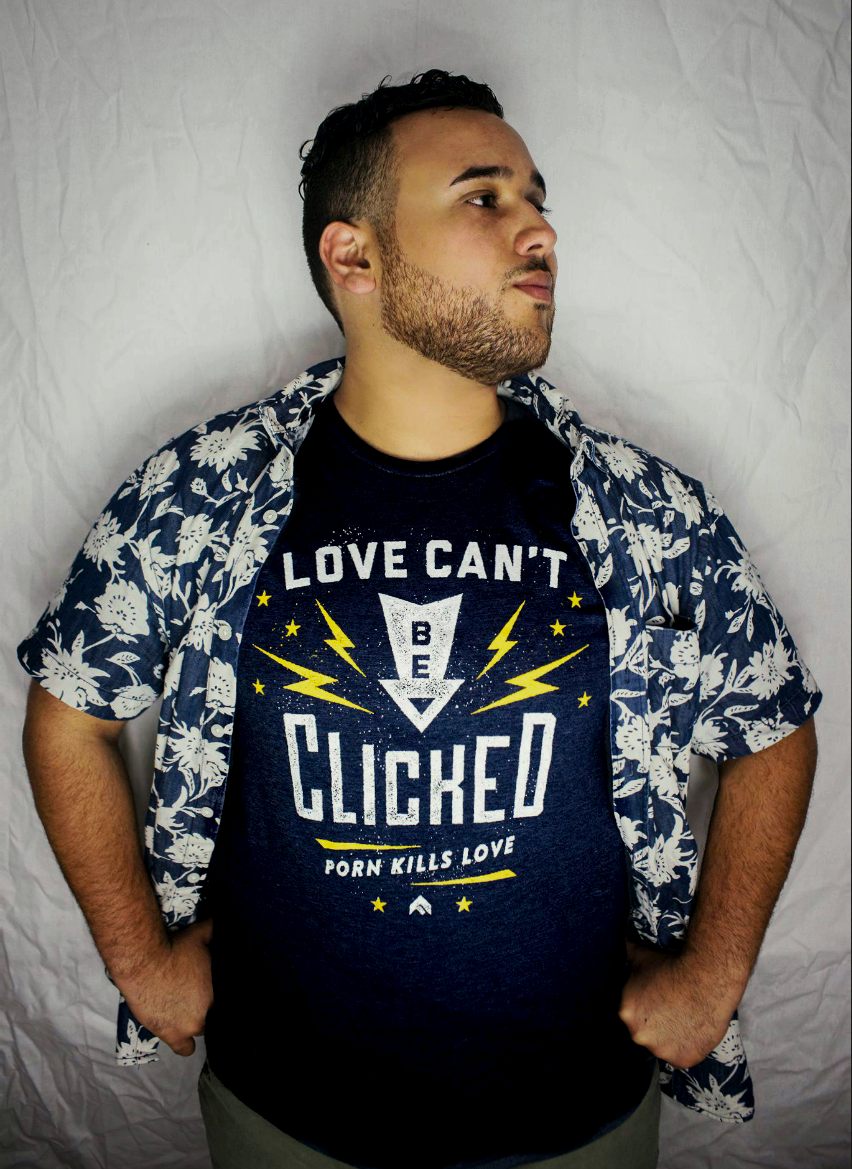Many people contact Fight the New Drug to share their personal stories about how porn has affected their life or the life of a loved one. We consider these personal accounts very valuable because, while the science and research is powerful within its own right, personal accounts from real people seem to really hit home about the damage that pornography does to real lives.
I remember the first time I wore my “Love Can’t Be Clicked” shirt to my university. It was a public speaking class, and that day we were choosing what topic we were going to do some research on and then expose a ten minutes’ presentation in front of 70 people.
We had total freedom to pick any topic to present, but apparently, I was the only one that did not have that privilege (and I am grateful for that). After the class was finish, my professor asked me if I could speak about the harmful effects of porn because my shirt grabbed her attention and she had experienced from first-hand in her marriage the catastrophic consequences that porn caused.
Three weeks later, I did my presentation. Eleven guys and four girls talked to me after because they recognized how their habit of watching porn was affecting them and their relationships.
Related: How You Can Bring Fight The New Drug To Your School/City (VIDEO)
In the list of the 10 Latin American countries that spend the most time watching pornographic content, Puerto Rico is number one. If you compare the population of the island of Puerto Rico (3.411 million people) vs. the biggest country in Latin America, Brazil (207.7 million people) this statistic is worrying.
A challenge that has always been present in Puerto Rico is to not speak about the effects of pornography.
After that presentation, little did I know, my professor shared with her colleagues about my stand. A few days later a Professor, that used to teach “Sexual Psychology” and is a sexual psychologist reached out to me because the university recognized that it was a health crisis among the student body. From speaking in front of 70 people I had the opportunity to bring the fight against porn to 400 people in a public university.
Today, I asked myself what would’ve happened if I never decided to wear my shirt to class and be brave enough to accept the challenge of bringing to the table a topic that is still a taboo but in the secret of homes is destroying so many people’s lives?
Related: Uncovering Latin America’s Fight Against The Sex Trafficking Crisis
In my case, I was terrified of public speaking. If that is your fear, I would like to remind you that we don’t know who needs to hear what we have to say and I would like to encourage you to speak. We, as fighters, can be “loud” in our way; you do not need to stand in front of 400 people to change your classrooms, workplaces, neighborhoods, etc. Sometimes we think we don’t have the power to change the world. We associate “changing the world” with talking to 10,000 people at the same time, but in my case, I decided to believe that I can change the world educating about the harmful effects of porn one person at a time.
But be on guard because you never know when the opportunity to talk to 10,000 people will knock on your door.
–Carlos-Daniel

Your Support Matters Now More Than Ever
Most kids today are exposed to porn by the age of 12. By the time they’re teenagers, 75% of boys and 70% of girls have already viewed itRobb, M.B., & Mann, S. (2023). Teens and pornography. San Francisco, CA: Common Sense.Copy —often before they’ve had a single healthy conversation about it.
Even more concerning: over half of boys and nearly 40% of girls believe porn is a realistic depiction of sexMartellozzo, E., Monaghan, A., Adler, J. R., Davidson, J., Leyva, R., & Horvath, M. A. H. (2016). “I wasn’t sure it was normal to watch it”: A quantitative and qualitative examination of the impact of online pornography on the values, attitudes, beliefs and behaviours of children and young people. Middlesex University, NSPCC, & Office of the Children’s Commissioner.Copy . And among teens who have seen porn, more than 79% of teens use it to learn how to have sexRobb, M.B., & Mann, S. (2023). Teens and pornography. San Francisco, CA: Common Sense.Copy . That means millions of young people are getting sex ed from violent, degrading content, which becomes their baseline understanding of intimacy. Out of the most popular porn, 33%-88% of videos contain physical aggression and nonconsensual violence-related themesFritz, N., Malic, V., Paul, B., & Zhou, Y. (2020). A descriptive analysis of the types, targets, and relative frequency of aggression in mainstream pornography. Archives of Sexual Behavior, 49(8), 3041-3053. doi:10.1007/s10508-020-01773-0Copy Bridges et al., 2010, “Aggression and Sexual Behavior in Best-Selling Pornography Videos: A Content Analysis,” Violence Against Women.Copy .
From increasing rates of loneliness, depression, and self-doubt, to distorted views of sex, reduced relationship satisfaction, and riskier sexual behavior among teens, porn is impacting individuals, relationships, and society worldwideFight the New Drug. (2024, May). Get the Facts (Series of web articles). Fight the New Drug.Copy .
This is why Fight the New Drug exists—but we can’t do it without you.
Your donation directly fuels the creation of new educational resources, including our awareness-raising videos, podcasts, research-driven articles, engaging school presentations, and digital tools that reach youth where they are: online and in school. It equips individuals, parents, educators, and youth with trustworthy resources to start the conversation.
Will you join us? We’re grateful for whatever you can give—but a recurring donation makes the biggest difference. Every dollar directly supports our vital work, and every individual we reach decreases sexual exploitation. Let’s fight for real love:


